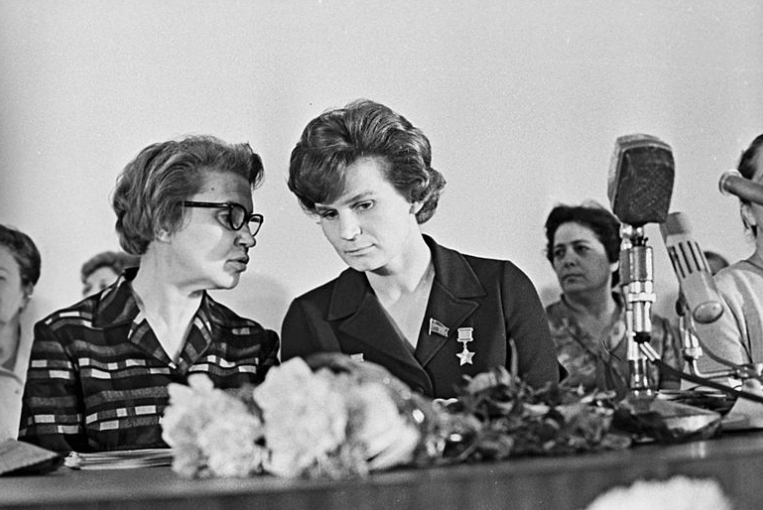Step into the time machine and take a journey back to 1935 in the USSR. As you delve into the pages of history, you’ll discover a remarkable shift taking place within the country’s workforce – an increase in women workers like never before! By this year, one out of every five individuals contributing to the Soviet Union’s labor force was a woman. This groundbreaking change not only transformed societal dynamics but also left an indelible mark on the future of women workers. Join us as we unravel the reasons behind this surge, explore its impact, and ponder what lies ahead for these trailblazing women in the USSR. So fasten your seatbelts and let’s embark on this captivating journey through time!
Read also Fred Korematsu argued that internment was unconstitutional mainly because internees
The Proportion of Women in the USSR’s Workforce
During the early 20th century, the USSR experienced a significant increase in the proportion of women workers in its workforce. By 1935, approximately one out of every five workers was a woman. This change marked a pivotal moment for gender equality and labor rights in Soviet society.
There were several reasons for this surge in female participation in the workforce. The Bolshevik Revolution of 1917 brought about sweeping social changes that aimed to dismantle traditional gender roles and promote equality between men and women. As part of this vision, opportunities for employment were extended to women across various sectors.
Additionally, industrialization played a crucial role in expanding job opportunities for women. The rapid growth of industries created demand for more laborers, leading to increased recruitment from both male and female populations. Women began working on assembly lines, operating machinery, and contributing to all aspects of production.
The rise in women’s participation had a profound impact on Soviet society as well as individual families. With more income sources available within households, families experienced improved economic stability. Moreover, with their newfound independence through work outside the home, women gained greater autonomy over their lives and decision-making processes.
Looking ahead at the future prospects for women workers in the USSR is promising but uncertain at best. While progress has been made towards gender equality within workplaces and legislation protecting women’s rights exists on paper; challenges remain rooted deeply within societal attitudes regarding gender roles.
In conclusion (as per instruction), it is undeniable that by 1935 there was a remarkable increase seen not only quantitatively but also qualitatively when it comes to involving women into Ukraine SSRs’ workforce! The efforts put forth by revolutionaries led to an overall elevation of living standards while simultaneously breaking down rigid patriarchal structures!
The Reasons for the Increase in Women Workers
The rise in the number of women workers in the USSR’s workforce during the 1930s can be attributed to several key factors. There was a strong push for industrialization and modernization under Joseph Stalin’s leadership, which required a larger labor force. Women were seen as an untapped resource that could help meet these demands.
The Soviet government implemented policies aimed at promoting gender equality and encouraging women to enter the workforce. Education became more accessible to women, allowing them to gain skills and qualifications needed for various job roles. Additionally, campaigns were launched to challenge traditional gender roles and stereotypes, empowering women to take on non-traditional jobs.
Furthermore, economic necessity played a role in driving women into the workforce. The Great Depression had hit many families hard, forcing them to rely on multiple sources of income. Women often stepped up to contribute financially by seeking employment outside their homes.
World War II further increased the demand for workers as men were drafted into military service. This led to even greater opportunities for women in sectors such as manufacturing and agriculture.
A combination of societal shifts towards gender equality, economic conditions, and wartime requirements all contributed significantly to the increase in female workers during this period in Soviet history.
Read also RFL Wardrobe Price: How to Build a Stylish Closet on a Budget
The Impact of the Increase in Women Workers
The increase in women workers had a profound impact on the USSR’s workforce. It significantly expanded the labor pool, allowing for increased productivity and output in various industries. With more women joining the workforce, there was a greater availability of skilled and unskilled workers to meet the demands of a growing economy.
Moreover, this increase brought about positive societal changes. Women were now able to contribute economically and gain financial independence. This newfound empowerment not only improved their own lives but also challenged traditional gender roles and norms. It paved the way for greater equality between men and women in Soviet society.
Additionally, with more women working outside their homes, childcare facilities became essential. The government recognized this need and invested in expanding daycare centers and preschools across the country. This provided working mothers with peace of mind knowing that their children were well taken care of while they contributed to the workforce.
Furthermore, by integrating more women into traditionally male-dominated sectors such as engineering and heavy industry, stereotypes were shattered. Women proved themselves capable of excelling in these fields just as much as their male counterparts did.
The increase in women workers not only bolstered economic growth but also fostered social progress within Soviet society. Their contributions helped shape a more inclusive workforce where talent rather than gender determined success – an invaluable achievement for both individuals and society at large.
The Future of Women Workers in the USSR
As the proportion of women workers in the USSR’s workforce continues to rise, it is clear that this trend will have a significant impact on the future. With every fifth worker being a woman by 1935, it is evident that gender equality and women’s empowerment are becoming increasingly important.
This increase in women workers can be attributed to several factors. First and foremost, the Soviet government has actively encouraged women to join the workforce through various policies and initiatives. Equal pay for equal work has been implemented, providing financial incentives for women to pursue employment outside their homes.
Additionally, education opportunities for girls have expanded significantly during recent years. As more women gain access to higher education, they are better equipped with skills and knowledge needed in various industries.
The impact of this rise in female workers cannot be underestimated. Women bring unique perspectives and talents to the table, enriching workplaces with diversity. Moreover, increased representation of women at all levels of society fosters societal progress towards gender equality.
Looking ahead into the future, it is crucial that efforts continue to support and uplift women in their professional pursuits. By creating inclusive work environments that value diversity and provide equal opportunities for growth regardless of gender or background will not only benefit individual careers but also contribute to overall economic development.
In conclusion (not conclusive), while there may still be challenges ahead on this journey towards workplace equality,
the increasing presence of women workers signifies promising prospects for a more equitable future within both Soviet society as well as internationally.
The Different Types of Keto Diets
When it comes to the ketogenic diet, there’s not just one way to do it. In fact, there are several variations that you can choose from based on your preferences and goals. Let’s take a closer look at some of these different types of keto diets.
1. Standard Ketogenic Diet (SKD): This is the most common type of keto diet, where you consume very low-carb (typically less than 50 grams per day), moderate-protein, and high-fat foods. It’s all about getting into ketosis and staying there.
2. Cyclical Ketogenic Diet (CKD): If you’re an athlete or someone who engages in intense physical activities regularly, this might be the right option for you. With CKD, you follow the standard keto diet most days but have planned carb refeed days once a week.
3. Targeted Ketogenic Diet (TKD): Similar to CKD, TKD allows for targeted carb intake around workouts to provide extra fuel for exercise performance without kicking yourself out of ketosis.
4. High-Protein Ketogenic Diet: As the name suggests, this variation focuses more on protein consumption while keeping carbs low like a typical ketogenic diet.
Each type has its own advantages and considerations depending on your lifestyle and goals. It’s important to find what works best for you while still maintaining ketosis and enjoying the benefits that come with it.
Read also What obstacles has Odysseus faced so far on his road of trials? Check all that apply.
Pros and Cons of a Keto Diet
Many people are turning to the keto diet as a way to lose weight and improve their overall health. But like any other diet, there are pros and cons to consider before jumping on the keto bandwagon.
One of the main benefits of a keto diet is its ability to promote weight loss. By drastically reducing carbohydrate intake and increasing fat consumption, your body enters a state of ketosis where it burns stored fat for fuel. This can lead to rapid weight loss in some individuals.
Another advantage of the keto diet is improved mental clarity and focus. When your body is running on ketones instead of glucose, many people report feeling more alert and focused throughout the day.
In addition, a keto diet has been shown to help control blood sugar levels in individuals with diabetes or prediabetes. By limiting carbohydrates, you can prevent spikes in blood sugar and potentially reduce insulin resistance.
However, there are also some drawbacks to consider when following a keto diet. One common side effect is known as the “keto flu.” During the initial stages of transitioning into ketosis, you may experience fatigue, headaches, nausea, or irritability.
Furthermore, because the ketogenic diet severely restricts carbohydrates and emphasizes high-fat foods such as bacon and butter, it can be challenging for some people to sustain long-term adherence. It may also lead to nutrient deficiencies if not carefully planned with an emphasis on nutrient-dense foods.
It’s important to note that while a keto diet may result in quick initial weight loss due to water loss from glycogen depletion; long-term studies looking at sustained weight loss outcomes are limited.
Overall
It’s clear that there are both advantages and disadvantages associated with following a ketogenic diet. If you’re considering this eating plan for yourself,
it’s essential
to weigh these pros
and cons
against
your personal preferences
and health goals.
Consulting with
a healthcare professional or registered dietician
can also be helpful
in determining whether the keto diet is right for you.
What Foods to Eat on a Keto Diet?
Following a ketogenic diet can be a great way to promote weight loss and improve overall health. But what exactly should you eat on a keto diet? The key is to focus on consuming foods that are low in carbohydrates and high in healthy fats.
First and foremost, prioritize fatty cuts of meat such as beef, pork, lamb, and poultry with the skin intact. These protein sources will not only keep you feeling satisfied but also provide essential nutrients. Seafood like salmon, tuna, and shellfish are also excellent options due to their omega-3 fatty acid content.
Next up on the menu are non-starchy vegetables. Think leafy greens like spinach or kale, cruciferous veggies such as broccoli or cauliflower, zucchini, bell peppers – basically anything that grows above ground. These vegetables offer vital vitamins and minerals while keeping carb intake minimal.
Healthy fats play a crucial role in maintaining ketosis. Avocados are an absolute superstar when it comes to providing both healthy fats and fiber. Nuts and seeds like almonds, walnuts chia seeds or flaxseeds make for satisfying snacks too.
Don’t forget about dairy products! Full-fat cheese is an excellent source of both fat and protein while being relatively low in carbs. Greek yogurt (unsweetened) can also be enjoyed occasionally but remember to check the label for added sugars.
Cooking oils such as olive oil or coconut oil should become kitchen staples since they’re high in healthy fats with minimal carbs.
Remember that every individual’s nutritional needs differ so it’s always best to consult with a healthcare professional before starting any new dietary regimen
Keto Recipes
Looking for some delicious keto recipes to add variety to your low-carb diet? Look no further! The ketogenic diet can be a fantastic way to promote weight loss and improve overall health. With its focus on high-fat, moderate-protein, and low-carb foods, it’s important to find recipes that not only adhere to these guidelines but also satisfy your taste buds.
Start your day off right with a mouthwatering breakfast of bacon and eggs cooked in butter. This classic combo is not only easy to make but will keep you feeling energized throughout the morning. For lunch or dinner, try a flavorful grilled chicken salad topped with avocado slices and drizzled with olive oil dressing.
Craving something sweet? Indulge in a creamy strawberry smoothie made with coconut milk and stevia as a sugar substitute. Or how about treating yourself to some rich dark chocolate fat bombs? These bite-sized delights are sure to satisfy any dessert cravings while staying within the parameters of the keto diet.
With so many options available, there’s no reason why following a ketogenic lifestyle should be boring or restrictive. Experiment with different ingredients and flavors to create dishes that excite your taste buds while keeping you on track towards your health goals.
Remember, always consult with a healthcare professional before starting any new diet plan or making significant changes to your current eating habits. Stay inspired, get creative in the kitchen, and enjoy discovering new favorite keto recipes along the way!
Read also Toggi Fun World Ticket Price and Packages for 2022
Alternatives to the Ketogenic Diet
If the ketogenic diet doesn’t appeal to you or doesn’t fit your lifestyle, fear not! There are plenty of alternative diets that can also help you achieve your health and weight loss goals. Here are a few options to consider:
1. Mediterranean Diet: This popular eating plan focuses on consuming fruits, vegetables, whole grains, lean proteins (such as fish and poultry), and healthy fats (like olive oil). It’s known for its heart-healthy benefits and emphasis on enjoying meals with family and friends.
2. Plant-Based Diet: Whether you choose to go vegetarian or vegan, a plant-based diet is centered around consuming mainly fruits, vegetables, legumes, nuts, seeds, and whole grains. It can provide ample nutrients while reducing the intake of animal products.
3. Flexitarian Diet: For those who want the best of both worlds—incorporating both plant-based foods and occasional meat consumption—the flexitarian diet offers flexibility without strict rules.
4. DASH Diet: Originally developed to help lower blood pressure, the DASH (Dietary Approaches to Stop Hypertension) diet emphasizes fruits, vegetables,
low-fat dairy products,
whole grains,
lean proteins (such as poultry),
and limited sodium intake.
Remember that finding the right eating plan should be based on what works best for your individual needs and preferences.
Conclusion
The increase in women workers in the USSR’s workforce by 1935 marked a significant milestone in gender equality and economic development. The proportion of women workers, with one in every five individuals being female, showcased the progress made towards creating equal opportunities for all.
This rise in women workers was driven by several factors including industrialization efforts, political ideology promoting gender equality, and the need to fill labor gaps left by men during periods of war. As more women entered various industries such as manufacturing, agriculture, healthcare, and education, they played a crucial role in driving economic growth and transforming society.
The impact of this increase was far-reaching. It not only provided women with new avenues for personal growth and financial independence but also contributed significantly to the overall productivity of the nation. Women proved themselves capable and skilled contributors to both domestic production and international trade.
Looking ahead into the future of women workers in the USSR, it is clear that their role will continue to evolve alongside societal changes. With ongoing efforts towards gender equality within education systems and workplaces alike, we can anticipate even greater representation of women across diverse sectors.
However, challenges remain on this journey towards full gender parity. Addressing issues like wage disparity between genders and ensuring equal access to leadership positions will be crucial steps forward. By continuing to invest resources into empowering women economically and socially while dismantling systemic barriers that hinder their progress, we can create an environment where every individual has an equal opportunity to thrive.
In summary,
the increasing proportion of women workers in the USSR’s workforce by 1935 reflected a progressive shift towards creating a more inclusive society.
Their contributions helped drive economic growth.
The future holds promise for further advancement; however,
there are still obstacles that need addressing.
By working together,
we can ensure that every woman has an equal chance at success
and contribute positively
to our shared future.
Read also Countdown to Mahalaya 2022: Embrace the Divine Awakening





 Shared joy is a double joy; shared sorrow is tymoff
Shared joy is a double joy; shared sorrow is tymoff